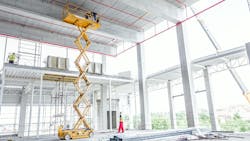Your scissor lift platform suddenly swayed, and one wheel even came off the ground. But the lift didn’t tip over. You got lucky — this time. But what about next time? The correct response to such an event is to lower the platform and conduct an analysis to determine what your mistake was. Did you lean too far over the guard rail? Perhaps you didn’t set the outriggers? Was the lift not level?
Don’t look for one deficiency and conclude that was the problem and it was just a one-off. “Oh, gee, I forgot to set the rigger on that side,” you might think. However, you should make a list of everything that was not perfect about this situation. Then address not only the errors you made but also what led up to them. You didn’t set the rigger because Tim stopped by and asked you about an issue with Line 3, so you decided to multi-task instead of stopping to have that chat and then — only after the chat — turning your full attention back to the scissor lift.
Another example: You almost got electrocuted due to inadvertent contact with a live terminal. That blew the tip off your screwdriver, but you’re okay this time. So what is the correct response to this event? If your answer is that you need to stop what you are doing and conduct an analysis to determine what your mistake was, then you answered correctly. That is always the first step when there’s a near miss or close call.
But there are so many different situations. Is there an analysis method that can work for all of them? Yes — in fact, several different methods will work. The five questions method is one. You slipped on oil, and your foot went flying. But you got lucky and caught the edge of a cabinet and prevented yourself from taking a nasty fall.
- Why did you slip? Because you weren’t watching where you were going.
- Why weren’t you watching where you were going? Because you were distracted by your phone.
- And so on….
For this same safety issue, you should also start a five question series on why the oil was there to begin with.
Another approach that works is the delta analysis. You begin by identifying the correct way of doing a task. You slipped with the knife and almost cut your hand. The correct way to make the cut includes supporting the work, putting your free hand behind the knife path (not in front of it), wearing cut-resistant gloves, having a sharp knife, and so on. Compare the way you did the job to this, and the delta (difference) is where you need to improve.
You might want to learn a new analysis method to help you work more safely or maybe not. Rather than learn a new method, why not apply whatever method you use for troubleshooting equipment failure down to its root cause? You are already familiar with the method, but now you would be using it to troubleshoot a safety failure down to its root cause.
The important thing is that you stop what you are doing to figure out what you did wrong. You may not be so lucky the next time, and by eliminating the next time, you also eliminate the need for luck to save you.
About the Author

Mark Lamendola
Mark is an expert in maintenance management, having racked up an impressive track record during his time working in the field. He also has extensive knowledge of, and practical expertise with, the National Electrical Code (NEC). Through his consulting business, he provides articles and training materials on electrical topics, specializing in making difficult subjects easy to understand and focusing on the practical aspects of electrical work.
Prior to starting his own business, Mark served as the Technical Editor on EC&M for six years, worked three years in nuclear maintenance, six years as a contract project engineer/project manager, three years as a systems engineer, and three years in plant maintenance management.
Mark earned an AAS degree from Rock Valley College, a BSEET from Columbia Pacific University, and an MBA from Lake Erie College. He’s also completed several related certifications over the years and even was formerly licensed as a Master Electrician. He is a Senior Member of the IEEE and past Chairman of the Kansas City Chapters of both the IEEE and the IEEE Computer Society. Mark also served as the program director for, a board member of, and webmaster of, the Midwest Chapter of the 7x24 Exchange. He has also held memberships with the following organizations: NETA, NFPA, International Association of Webmasters, and Institute of Certified Professional Managers.
